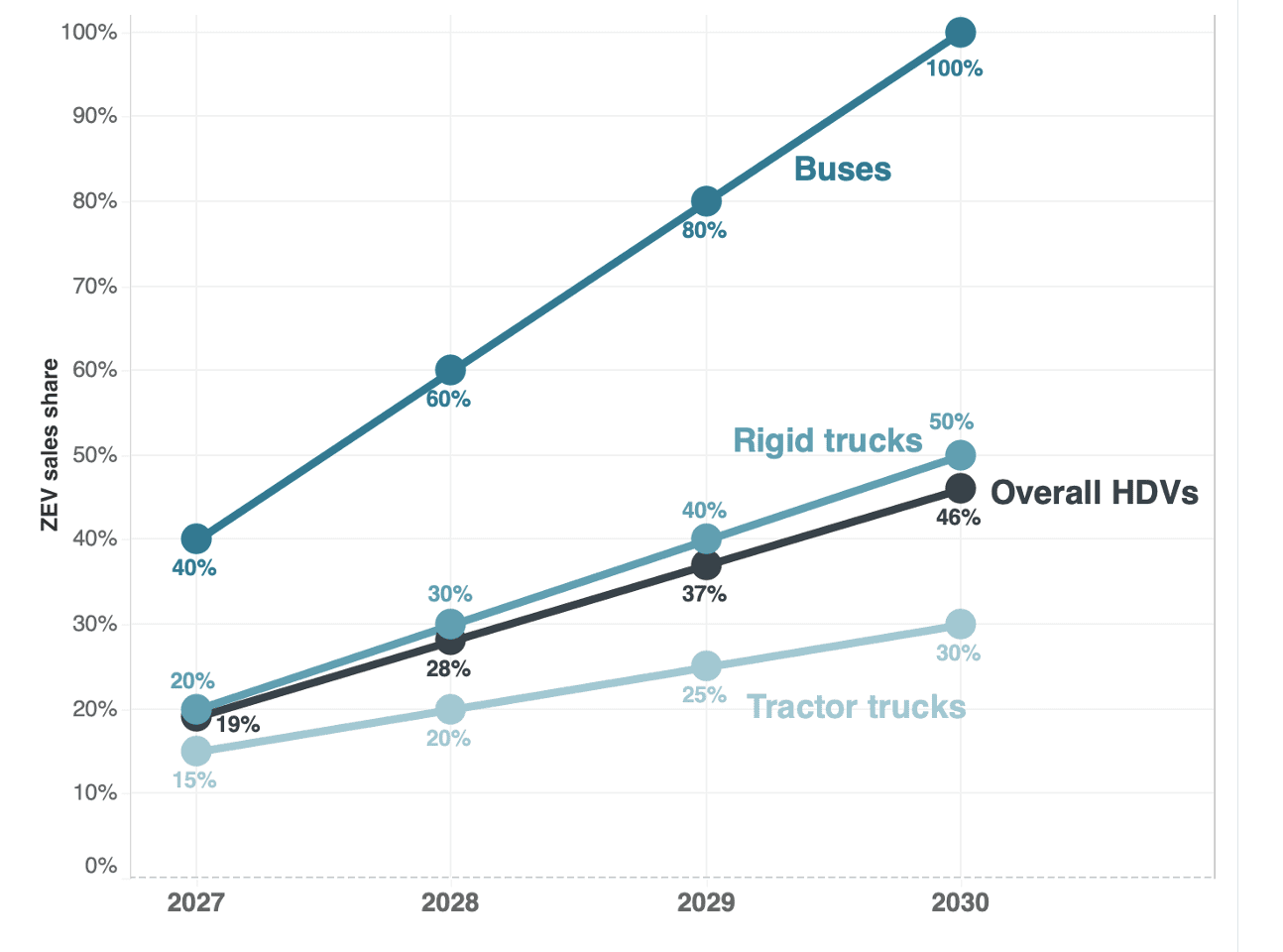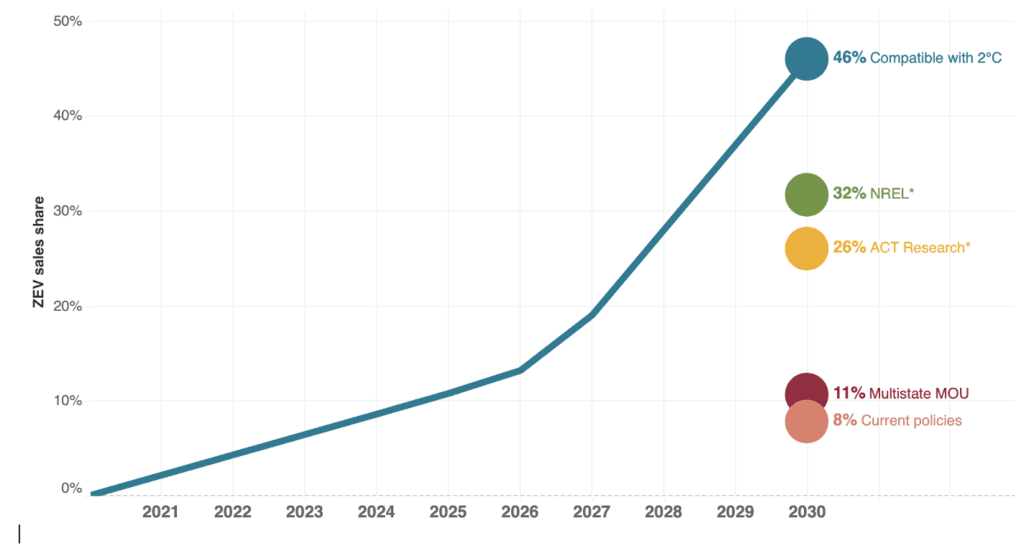Blog
Racing to zero: The ambition we need for zero-emission heavy-duty vehicles in the United States
Last month, the EPA proposed new emission standards for heavy-duty vehicles, starting in model year 2027. Embedded in their 475-page proposal are new low-NOx standards, revised greenhouse gas standards, and a critical opportunity to set the U.S. on a path towards zero-emission heavy-duty transportation. In the proposal, the EPA assumes a zero-emission vehicle (ZEV) sales share of only 1.5% in key market segments in 2027, which is lower than state-level policies already require and nowhere near compatible with a 2°C climate target. But EPA’s standards are intended to be technology-forcing and they’ve asked for input on what federal ZEV targets should be. This begs the question: how many heavy-duty ZEVs do we need to put us on a less-than-2°C trajectory?
The heavy-duty vehicle market has made great progress towards zero-emission technologies in the last few years. In 2020, California’s Advanced Clean Trucks (ACT) regulation broke new ground by setting the world’s first zero-emission sales requirements for heavy-duty vehicle manufacturers, which have since been adopted by five other states. And California plans to come back again this year with a new regulation requiring the largest truck and bus fleets to transition to ZEVs. Manufacturers are quickly getting on board, with Volvo committing to sell 50% zero-emission trucks globally by 2030 and Daimler Trucks teasing a full zero-emission product line-up by 2027. The latest technology and cost assessments—from ANL, NREL, CARB, and others—also have zero-emission heavy-duty vehicles primed to break onto the main stage. With this cost calculus, fleet owners are making strong commitments to electrify their vehicles. For example, Amazon has pledged to make 50% of shipments carbon-neutral by 2030, and FedEx recently announced plans to fully electrify last-mile deliveries by 2040.
So, there’s already a lot of momentum. But how much momentum do we need to meet climate targets? An ICCT analysis found that a 2030 target of 45% zero-emission sales in the U.S. heavy-duty vehicle sector is compatible with limiting warming to less than 2°C. And even more would be needed to limit warming to 1.5°C.
Let’s imagine that the EPA revised its standards to align with zero-emission sales targets set by the ACT. This would mean 50% zero-emission rigid truck sales and 30% zero-emission tractor truck sales in model year 2030. (Figure 1.) Since EPA’s proposal for greenhouse gases shifts most Class 2b-3 trucks and vans to the forthcoming light- and medium-duty rulemaking, we’ll stick to Class 4-8 vehicles here. Of those vehicles, federal action is specifically needed to require electrification of long-haul trucks, since they are not easily addressed by state-level policies. Let’s also imagine that buses achieve 100% zero-emission sales by 2030, similar to California’s level of ambition in the Innovative Clean Transit (ICT) regulation. Together, these zero-emission truck and bus sales targets would add up to 46% overall heavy-duty ZEV sales in model year 2030, the same level of ambition needed to meet a 2°C climate target. What this means is that if federal policy were as ambitious on heavy-duty ZEVs as leading state regulations are, the heavy-duty sector would be put on a course compatible with a 2°C future.

Figure 1. Heavy-duty ZEV sales targets compatible with 2°C.
Let’s take a quick temperature check on current policies driving progress toward this 2°C-compatible target. With 6 states adopting the ACT regulation—representing roughly one-fifth of heavy-duty trucks nationwide—10% of new rigid trucks and 6% of new tractor-trailers will be required to be zero-emission in model year 2030. At least 2% of all new buses nationwide will also be zero-emission by 2030 due to California’s ICT rule. Across the heavy-duty sector, this works out to just under 8% zero-emission sales overall, a far cry from the level necessary for a 2°C-compatible future.
A memorandum of understanding signed by 17 states and the District of Columbia signals state-level ambition beyond currently adopted policies. The MOU sets a target of 30% zero-emission sales of all new trucks and buses by 2030. Together, these states and D.C. represent about 36.5% of heavy-duty vehicles nationwide. This works out to 11% heavy-duty ZEV sales nationally in 2030.
Some cost-based projections of the heavy-duty vehicle market highlight its readiness for zero-emission technologies, above and beyond states’ ambitions. The firm ACT Research forecasted a 26% sales share of heavy-duty ZEVs nationwide in 2030. (Figure 2.) NREL has projected that an even higher share—roughly 32%—of heavy-duty vehicle sales will be zero-emission by 2030, without accounting for incentives. Such projections underscore the considerable economic potential for heavy-duty ZEVs, bolstering the case for EPA to raise its regulatory ambition on zero-emission technologies.

Figure 2. Heavy-duty ZEV sales targets and projections. (* indicates projection)
The federal government has an important role to play in closing the gap to a 2°C pathway—a role that can’t be outsourced to states—and EPA’s proposal falls far short. Current Phase 2 greenhouse gas standards, adopted in 2016, include provisions intended to incentivize early adoption of ZEVs in the heavy-duty sector. Anticipating significant uptake from state-level policies, the EPA has proposed to update these standards to reflect a faster-growing market for heavy-duty ZEVs than was previously expected. However, the EPA only assumes 1.5% ZEV uptake in several early-adopting market segments in model years 2027–2029. Not only is this an order of magnitude lower than a 2°C-compatible pathway, it’s even lower than required by current state-level policies: 3% in 2027, increasing to 8% by 2030. Meanwhile, Canada has aimed much higher, announcing a 35% sales target for heavy-duty ZEVs in 2030.
While new U.S. Phase 3 greenhouse gas standards are looming, model year 2030 is the earliest they could take effect—and that’s much too late. What we’ve shown here is that a 50% zero-emission sales target for rigid trucks in model year 2030, combined with 30% for tractor-trailers and 100% for buses, would put the U.S. heavy-duty sector on a path to limit warming to 2°C. To meet those sales targets, EPA’s 2027–2029 standards must go much further to accelerate adoption of heavy-duty ZEVs. As proposed last month, they won’t even get us out of the starting blocks.
